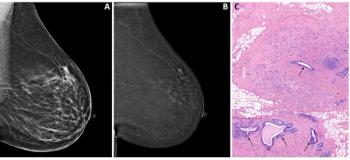MRI or Ultrasound for Evaluating Pelvic Endometriosis?: Seven Takeaways from a New Literature Review
While noting the strength of MRI for complete staging of disease and ultrasound’s ability to provide local disease characterization, the authors of a new literature review suggest the two modalities offer comparable results for diagnosing pelvic endometriosis.
Noting the challenges of diverse symptom presentation, disease burden and lesion location for endometriosis, a condition with an average delayed diagnosis of 6.7 years, researchers recently performed a literature review of 33 studies to ascertain whether magnetic resonance imaging (MRI) or ultrasound is more effective in detecting pelvic endometriosis.
Here are seven pertinent takeaways from the recently published literature review in the
1. While superficial endometriosis may be characterized by punctate foci of hyperintensity on T1-weighted MRI and non-specific hypointense thickening on T2-weighted MRI, deep endometriosis involves tethering of hypointense and spiculated lesions to adjacent structures on T2-weighted MRI. One may also see foci of hyperintense blood products on T1-weighted imaging and hyperintense glandular structures on T2-weighted imaging in cases involving deep endometriosis.
2. When there is ureteral involvement of endometriosis, the literature review authors said transabdominal ultrasound can be effective in assessing hydronephrosis. However, for pelvic endometriosis, they emphasize that transvaginal ultrasound (TVUS) provides enhanced spatial resolution as well as visualization of the pelvic organs of the central pelvis.
3. For pelvic MRI, the review authors maintained that multiplanar turbo spin-echo (TSE) is the most essential MRI sequence. Obtained without fat suppression, the high-resolution TSE sequence enables one to have axial views of uterine ligaments and sagittal views of the uterus, anterior and posterior compartments, according to the lead review author Angela Tong, M.D., an abdominal radiologist at the New York University Grossman School of Medicine, and colleagues.
4. In their review of 14 studies on imaging of endometriomas, Tong and colleagues noted similar weighted mean specificities of 84.4 percent for ultrasound and 83.2 percent for MRI. However, the review authors noted the weighted mean sensitivity rate for ultrasound was over 14 percent higher than MRI (81 percent vs. 67.8 percent).
5. For the detection of endometriosis in the anterior compartment of the pelvis, the researchers noted weighted mean specificity of 99.4 percent for ultrasound and 99 percent for MRI based on 17 studies. However, they noted lower weighted mean sensitivity rates for ultrasound (56.8 percent) and MRI (73 percent). Tong and colleagues pointed out that an underdistended bladder can obscure subtle irregular presentations of endometriosis and the disease can also be hidden in the bladder wall and uterovesical fold on MRI.
6. In their review of 21 studies looking at endometriosis with uterosacral ligaments (USLs), the researchers found weighted mean sensitivities of 60 percent for MRI and 82.3 percent for ultrasound. They cautioned that removing one 2022 study with 97.3 percent sensitivity findings from one expert sonographer lowered the weighted mean sensitivity to 56.9 percent for ultrasound. However, Tong and colleagues also noted that ultrasound provides better visualization than MRI of subtle nodular thickening, which is key to the diagnosis of endometriosis with USLs.
7. Noting that endometriosis cases often have extraperitoneal involvement, the researchers said studies have found robust specificity rates for TVUS (98.2 percent) and MRI (98.6 percent) in detecting endometriosis of the pelvic side wall. However, the review authors emphasized that MRI’s larger field of view facilitates enhanced sensitivity for extraperitoneal disease. For pelvic side wall involvement, MRI offered a greater than 42 percent higher sensitivity rate than TVUS (58.3 percent vs. 15.4 percent), according to Tong and colleagues.
Newsletter
Stay at the forefront of radiology with the Diagnostic Imaging newsletter, delivering the latest news, clinical insights, and imaging advancements for today’s radiologists.































